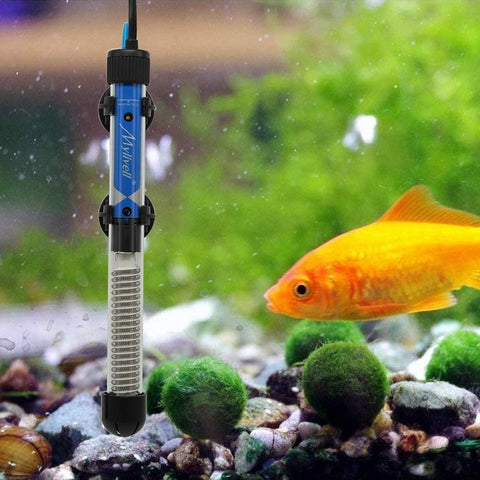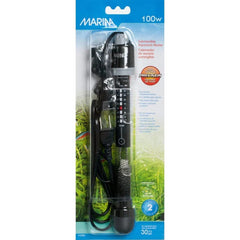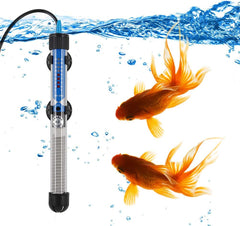One key element in maintaining optimal water conditions for aquaponics systems is temperature control; water heaters are indispensable. Water heaters allow growers to regulate water temperatures within a range conducive to the health and growth of fish and plants. In this article, we will discuss water heaters for aquaponics and explore why they are an essential tool. We will also discuss the different water heaters available and how to choose the right one for your specific system.
The Role of Water Heaters in Aquaponics Systems
Water quality is essential in aquaponics as the health and growth of fish and plants are directly influenced by water quality parameters such as pH, dissolved oxygen, water temperature, and many more. The water temperature must be carefully controlled and maintained within a specific range for the system to thrive. This is where water heaters come into play.
Aquaponics water heaters serve as the thermostat that ensures the aquatic environment remains within the ideal temperature range for the organisms it supports. Fish, in particular, are susceptible to temperature fluctuations, and variations outside their preferred range can lead to stress, slow growth, or even death. On the plant side, temperature impacts nutrient absorption and metabolic processes, influencing growth rates and crop yields.
Water heaters are the guardians of stability in an aquaponics system. They prevent extreme temperature fluctuations due to weather conditions or other environmental factors and provide a consistent and comfortable environment for fish and plants.

How Water Heaters Help Maintain Ideal Temperature Range of an Aquaponics System
Water heaters help maintain the ideal temperature ranges fish and plants require for optimal growth. These devices function as thermostats for the aquatic environment and ensure that water temperatures remain within the desired parameters, regardless of external weather conditions.
Water heaters work by warming the water in the fish tanks and grow beds, thus creating a stable and controlled environment. This consistency is vital for the inhabitants of the aquaponics system, as it reduces the stress and shocks caused by temperature fluctuations. By maintaining the proper water temperature, these heaters enable fish to grow at their maximum potential and plants to thrive in an environment optimized for nutrient absorption.
In regions with extreme climates, water heaters become indispensable. During cold winters, heaters prevent the water from plummeting to temperatures that can harm fish. In hot summers, they help prevent water from overheating, depriving fish of oxygen and hindering plant growth.
Types of Water Heaters for Aquaponics Fish Tanks
Below are the three types of water heaters that are often used in aquaponics systems.
1. Submersible Water Heaters
Pros:
- Submersible water heaters are energy-efficient, as they heat the water directly without significant heat loss, making them cost-effective in the long run.
- They can heat water rapidly, providing hot water almost instantly when needed.
- They are compact and don't require much space, making them suitable for smaller areas.
- Many models allow users to adjust the immersion depth, enabling customization for different water quantities.
- They are easy to install and require minimal plumbing work.
Cons:
- Submersible water heaters are designed for smaller water volumes, so they are not suitable for heating large quantities of water.
- They are prone to scaling and sediment buildup, which may require regular maintenance and cleaning.
- Electrical shock is risky if not properly installed or used, so professional installation is recommended.
- Submersible water heaters can generate noise when heating water, which may be a concern in quiet environments.
2. Immersible Water Heaters
Pros:
- Immersible water heaters often offer precise temperature control, allowing you to maintain the ideal water temperature for your fish and plants.
- They are suitable for small and large aquaponics systems.
- They are typically energy-efficient, as they heat the water directly without significant heat loss, helping to keep operating costs low.
- They are easy to install and can be placed directly in the water.
- Immersible heaters are known for their reliability and long lifespan when appropriately maintained.
Cons:
- If not monitored or set correctly, immersible water heaters can lead to overheating, potentially harming your aquatic life.
- They may not distribute heat evenly in larger aquaponics systems, requiring multiple units or additional water circulation to ensure uniform temperatures.
- Like all water heaters, they can accumulate mineral deposits and require regular cleaning and maintenance to function efficiently.
- Immersible heaters occupy space within the water, which may limit the available area for fish and plant growth, particularly in smaller tanks.
3. In-line Water Heaters
Pros:
- In-line water heaters offer precise temperature control, which allows growers to maintain the ideal water temperature for fish and plants in an aquaponics system.
- These heaters are typically energy-efficient.
- In-line heaters can distribute uniform heat in larger aquaponics systems, ensuring consistent water temperatures.
- They do not take up space within the tank.
- In-line heaters are considered safer, as the heating element is outside the water, which reduces the risk of damage to aquatic life and electrocution.
Cons:
- High-quality in-line water heaters can be more expensive to purchase.
- Installing an in-line heater may require modifications to your aquaponics system's plumbing, which can be more complex and need professional help.
- Some in-line heaters may have limitations on water flow rates.
- Not all in-line heaters are compatible with all aquaponics systems.
Top Water Heater for Aquaponics Fish Tanks
1. Marina Glass Heater
The Marina Glass Heater has been a fantastic addition to my aquarium setup. It's easy to install, maintains a consistent water temperature and its slim design doesn't obstruct the view of the tank. It's also durable and provides excellent value for the price. It is highly recommended for aquarium enthusiasts.
2. Mylivell Aquarium Heater
The Mylivell Aquarium Heater has been a reliable choice for my fish tank. It offers accurate temperature control, easy to install, and maintains a consistent water temperature. Its compact design doesn't disrupt the aesthetics of the aquarium, and it has proven to be durable over time. This heater provides great value for its cost, making it an excellent choice for aquaponics growers who use aquarium fish tanks.
3.Inkbird ITC-308S Aquarium Heating and Cooling Dual Stage Temperature Controller
The Inkbird ITC-308S is a game-changer for aquarium enthusiasts. It offers precise temperature control with both heating and cooling capabilities. Easy to install and use, it keeps water temperatures consistent, ensuring the well-being of your aquatic life. Its durability and reliability make it a must-have for any aquarium setup.
How to Choose the Right Heater for Your Fish Tank
Buying a water heater without adequately sizing your system is a common mistake many aquaponics growers make. To choose the right heater size for your system, take note of your tank's total water volume, the average room temperature where your fish tank is located, and the optimal water temperature range for the fish.
Installation and Maintenance Tips
Ensuring the proper installation and regular maintenance of your water heater is essential for the efficient operation of your system. Here are some installation and maintenance tips to follow:
1. Proper Installation Guidelines
- Choose the Right Location: Select a suitable location for your water heater based on safety and accessibility. Ensure there is enough space for installation, and consider factors like ventilation and proximity to water and electricity sources.
- Follow Manufacturer Instructions: Follow the manufacturer's installation instructions for your water heater. Different types of heaters may have specific requirements that must be followed.
- Ventilation and Gas Heaters: Proper ventilation is essential if using a gas heater. Ensure that exhaust gases are safely vented outside to prevent indoor air pollution. Professional installation may be necessary.
- Secure Wiring and Connections: For electric heaters, ensure that wiring and connections are safe and meet safety standards. Proper grounding is critical to prevent electrical hazards.
- Plumbing Connections: Make sure plumbing connections are leak-proof and adequately sealed. Check for any drips or leaks regularly.
- Solar Heater Positioning: If using a solar heater, position the collectors to maximize exposure to sunlight. This may require a south-facing orientation and an angle that optimizes solar energy absorption.
2. Regular Maintenance Practices
- Inspect for Leaks: Regularly check for leaks or drips around the water heater, plumbing connections, and valves. Address any leaks promptly to prevent water loss and damage.
- Clean Heating Elements: Inspect and clean heating elements periodically for electric heaters. Accumulated mineral deposits can reduce their efficiency.
- Gas Heater Safety Checks: If you have a gas heater, schedule regular safety inspections by a professional to ensure proper ventilation and safe operation.
- Solar Heater Maintenance: Clean the solar collectors to remove dust and debris that can reduce heat absorption. Inspect the system for leaks or damage.
- Temperature Monitoring: Monitor and adjust the water temperature to ensure it remains within the ideal range for your aquaponics system.
- Inspect Electrical Connections: Regularly inspect electrical connections and wiring for signs of wear, damage, or loose connections.
3. Troubleshooting Common Issues
- Inadequate Heating: If the water temperature is not reaching the desired range, check for issues like a malfunctioning thermostat, insufficient heater capacity, or poor insulation. Adjust or replace components as needed.
- Overheating: If water is consistently overheating, consider installing a thermostat or using a timer to cycle the heater on and off. You may need to adjust the angle or insulation to control heat gain for solar heaters.
- Leaks: Leaks can occur due to damaged pipes, valves, or pressure relief valves. Identify the source of the leak and repair or replace the affected components.
- Sediment Buildup: In electric heaters, sediment buildup on heating elements can reduce efficiency. Periodically flush the tank to remove sediment.
- Gas Heater Issues: For gas heaters, problems may include pilot light issues, gas line obstructions, or thermocouple malfunctions. Consult a professional for troubleshooting and repairs.
FAQs About Water Heaters for Aquaponics
Here are some common questions and answers to address your aquaponics water heater concerns:
1. Why do I need a water heater for my aquaponics system?
A water heater is essential for maintaining the ideal water temperature for both fish and plants. It helps prevent temperature fluctuations that can stress or harm your aquaponic organisms.
2. What is the ideal water temperature for my aquaponics system?
The ideal water temperature varies depending on the fish and plants in your system. Common temperatures range from 72°F to 78°F (22°C to 26°C), but specific species may have different requirements.
3. How do I calculate the heater size I need for my aquaponics system?
The heater size depends on the volume of water and the desired temperature rise. Use a heater sizing calculator or consult with the manufacturer to determine the appropriate size for your system.
4. Are there safety concerns with gas water heaters in aquaponics?
Gas water heaters should be installed and maintained with safety in mind. Ensure proper ventilation to prevent indoor air pollution and consider professional installation for gas heaters.
5. What should I do if my water heater is not maintaining the desired temperature?
Check for issues like a malfunctioning thermostat, insufficient heater capacity, or poor insulation. Adjust or replace components if needed to maintain the desired temperature.
6. Can I use more than one water heater in my aquaponics system?
You can use multiple water heaters in larger systems to distribute heating evenly. This can be particularly useful if your system has numerous fish tanks or growing areas.
7. Do I need a backup heating system for my aquaponics setup?
Having a backup heating system is a good idea, especially in areas prone to power outages or if your primary heater is prone to issues. Backup heaters can help maintain the water temperature during emergencies.
Conclusion
The role of water heaters in aquaponics systems is crucial, especially if you live in areas with colder climates. They help control temperature changes and ensure the whole system remains a haven for fish and plants. As you continue your aquaponics journey, keep in mind that the choices you make, from the type of water heater to the maintenance practices you follow, will have a profound impact on the success of your aquaponics system. So, choose a water heater that is appropriate for the size of your system to ensure a successful system.









Leave a comment (all fields required)